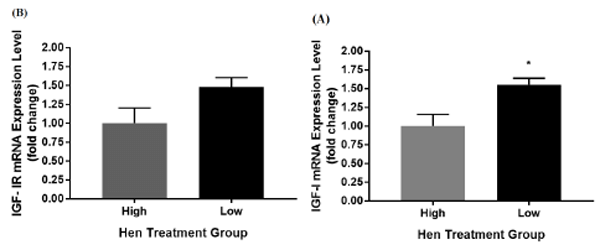Maternal Feed Restriction Upregulates Insulin-Like Growth Factor I Expression in 42 Day Old Male Progeny
Published: February 25, 2022
By: J. ANGOVE 1, G. NATTRASS 2, N. WILLSON 1, P. HYND 1 and R. FORDER 1 / 1 School of Animal and Veterinary Sciences, University of Adelaide; 2 Yalumba Wine Company, Angaston, 5353, Australia.
Environmental factors encountered during pre-natal life influence the developmental trajectory of a developing embryo, altering post-natal phenotypes (Du et al., 2015). Maternal nutrition and stress directly influence the maternal environment, with both factors prominent in the broiler breeder industry. Broiler breeders are feed restricted to improve reproductive output; however evidence suggests hens suffer from chronic stress due to prolonged hunger (Mench, 2002). Feed restriction in breeder hens is reported to reduced progeny growth rates (Hynd et al., 2016); however, the mechanisms by which it does so remains unclear. Glucocorticoids have been shown to interact with various endocrine pathways, including the growth hormone/insulin-like growth factor I axis, a key regulator of growth and metabolism in poultry.
Therefore a study was designed to investigate whether feed restriction in breeder birds influenced male progeny insulin-like growth factor I (IGF-I) hepatic mRNA expression and plasma concentrations. 36 broiler breeder hens where separated into three groups based on maternal body weight (bwt) (high, medium, low) at 24 weeks of age and fed accordingly to maintain their bwt until 43 weeks of age. Eggs were collected at 42 weeks of age and 170 viable chicks hatched. Progeny were housed in groups of 10, and reared together until 42 days of age, when 69 birds (23 per treatment) were euthanised. IGF-I and other related gene mRNA expression was determined by Q-PCR, whilst IGF-1 plasma concentrations were analysed via ELISA.
IGF-I mRNA expression was increased in progeny produced from low maternal bwt hens (P = 0.020), accompanied with an up regulation of IGF-I receptor (IGF-IR) expression (P = 0.097) (Figure 1), whilst no difference was observed in IGF-I plasma concentrations. However, these findings suggest that maternal feed restriction and/or low maternal bwt may reduce the synthesising capacity of IGF-I during early post-hatch development.
Figure 1 - IGF-I (A) and IGF-IR (B), mRNA expression for day 42 male broiler chicken progeny produced from low maternal bwt (low) or high maternal bwt (high) breeder hens. qPCR data shown as mean fold change ± SEM. * denotes statistical significance between at the 0.05 confidence level.

Presented at the 31th Annual Australian Poultry Science Symposium 2020. For information on the next edition, click here.
References
Du M, Wang B, Fu X, Yang QY & Zhu MJ (2015) Meat Science 109: 40-47.
Hynd PI, Weaver S, Edwards NM, Herbele ND & Bowling M (2016) Anim. Prod. Sci. 56: 1233-1238.
Mench JA (2002) Worlds Poult. Sci. J. 58: 23-29.
Related topics:
Authors:
University of Adelaide
University of Adelaide
Recommend
Comment
Share

Would you like to discuss another topic? Create a new post to engage with experts in the community.








.jpg&w=3840&q=75)